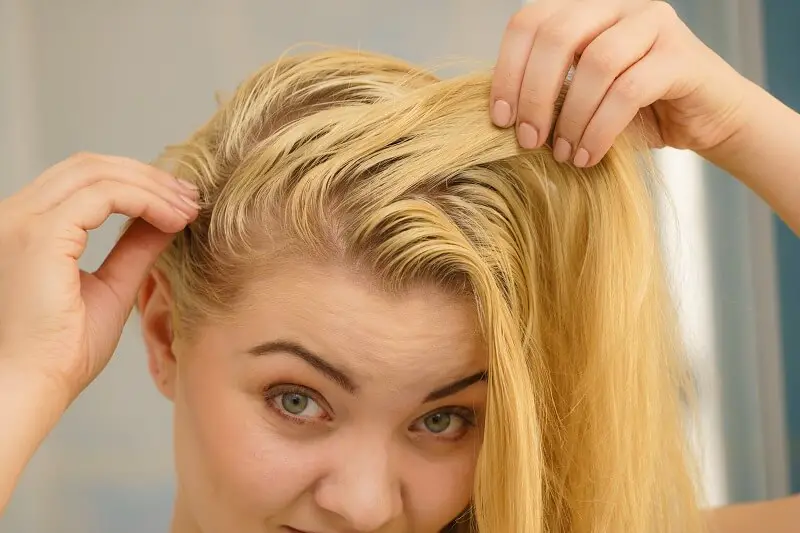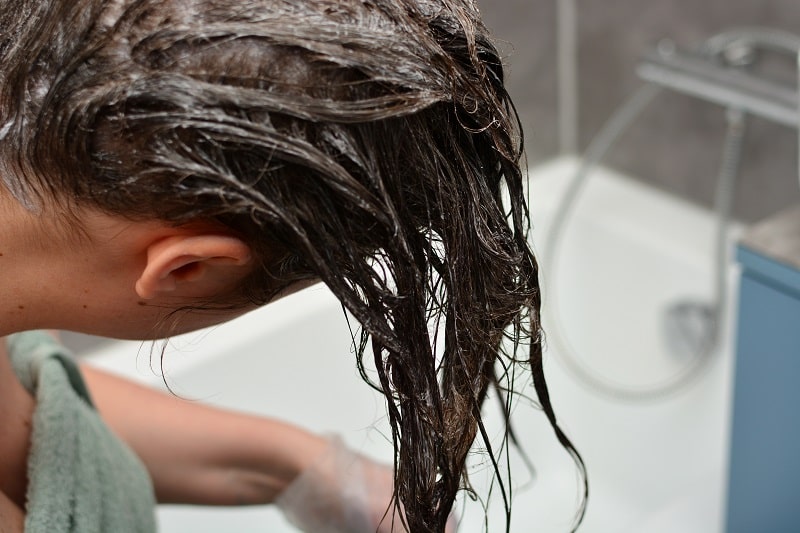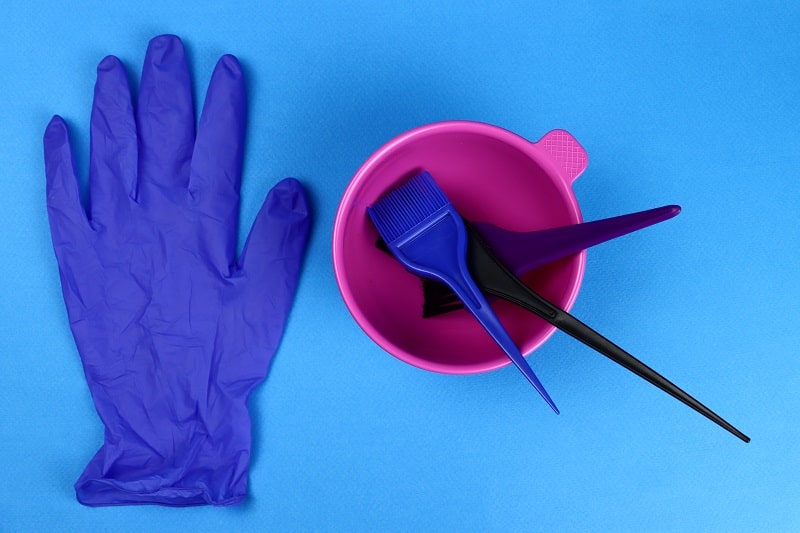There may not be anything more frustrating than spending 20 minutes (or more) in the shower washing and conditioning your hair, only to have it dry and feel worse than it did pre-shower. As you run your fingers through your freshly cleaned hair you may wonder—why does my hair feel waxy?
There are a variety of reasons your hair may feel as though you’ve taken a nice hot bath inside a candle. I’m exaggerating—however, the reason your hair may feel waxy, even after you’ve showered may be a simple fix, or it may just be a part of your body’s chemical makeup.
Either way, this article will discuss all the nitty-gritty details when it comes to waxy hair. So, stay with me to dig into this troubling issue and find out what you can do to fix it.
Why Does My Hair Feel Waxy Even After Washing It?
There is an assortment of reasons why someone’s hair may feel waxy. Sometimes it may be caused simply by the products you’re using. Other times it may be in part to the amount of product being used. Other times, it may be caused by your genetic makeup.
Nonetheless, when it comes down to it, the health of your hair relies on the health of your scalp. If there is an issue with your scalp, it’s likely to affect each and every strand on your head.
Sebum
This direct streamline, from the root, all the way down to the ends, is precisely why those that struggle with seborrhea may find that their hair has a waxy consistency. We all produce sebum from the sebaceous glands on our scalp.
Sebum is a naturally occurring waxy oil, used as a defensive mechanism against infection, along with keeping our hair moisturized. While every person’s body creates a different amount of sebum, some may overproduce this oil, causing an oily, yet flaky scalp.
This common form of eczema causes the excess sebum being produced to build up on your scalp, resulting in greasy and waxy hair. Those with fine or straight hair are more commonly affected by the waxy effect of overproduced sebum.
Reusing Self-Care Items
We’ve all used a towel one too many times to avoid throwing in another load of laundry. However, towels aren’t the only culprit contributing to waxy hair. Reusing items such as brushes, hats, or headscarves excessively can cause waxy residue to stick.
This is due to our hair picking up any sebum left behind, thus redepositing it with every re-use. When it comes time to towel dry your wet hair, use a hair wrap made of either silk or satin, as these fabrics don’t absorb excess oil, thus avoiding any redeposit.
Incorrectly Rinsing Your Hair
This may come off as the simplest answer, however, even if you have your hair washing routine down to an art, you may be rinsing your shampoo out all wrong—causing product to be left behind.
When a product is left behind on our hair it leaves a ‘coating’, causing a waxy buildup. To avoid this, thoroughly rinse your hair for 1-2 minutes after shampooing.
Since dry hair can trigger the production of excess oil, if you suffer from brittle, dehydrated hair, you may want to consider turning that faucet over to cold, as it seals the shaft and leaves hair stronger.
Product Build-Up
If the hair care world isn’t amateur hour for you, you may have heard this reason for why some people may experience waxy hair. Hairstyling products such as shampoo or conditioner can leave behind a pesky wax residue, causing a buildup.
Any product containing silicones, polymers, and oils is more likely to stick around on the surface of your hair strands since they are water-resistant. Not only are these three ingredients likely to leave you with a waxy feel, but they can also cause either dry or oily hair.
Why Does My Hair Feel Waxy After Bleaching?
It shouldn’t come as a shock to anyone reading this, but, bleach damages your hair. We all have heard horror stories of women who were aiming for that platinum, Playboy model blonde, only to be left with hair that has been chemically fried, or worse, has fallen out.
This being said, bleaching strips your hair of proteins. When this happens, the hair is classified as chemically damaged, as the protein-moisture balance is thrown off, causing a gummy, waxy feel.
Due to the extensive time it takes for the hair to reproduce protein naturally, some opt for a drastic hair cut to solve their problem. Don’t worry, this isn’t the only option out there—we’ll discuss that coming up.
Why Does My Hair Feel Waxy After Coloring?
One of the most common reasons your hair may feel waxy after dyeing it, is because it has become oversaturated with products. This can stem back weeks or months with your shampoo, conditioner, thermal heat protectant, leave-in serums, etc.
As the days go on, your hair accumulates products. You may not even notice it happening at first. Then, one day, as you’re going through a breakup, you decide you need a change and you dye it black.
Well, the black hair dye was the straw that broke the camel’s back and your hair couldn’t hold any more product buildup, so you’re then left with a waxy film—not exactly ideal when going through a quarter-life crisis.
Why Does My Hair Feel Waxy After Shampoo?
A majority of drugstore shampoos contain a chemical known as silicone. The draw to silicone is in the incredible shine and body your hair will have—but only after the first few washes. After that, silicone begins to leave a gummy film behind.
This is because silicone doesn’t allow the hair to breathe. Over time your hair may begin to appear dull, weak, or prone to breakage. Not only does silicone cause hair to feel waxy, but over-shampooing can also be to blame.
Someone struggling with naturally oily or greasy hair may conclude that they just need to wash their hair more. While this train of thought may seem logical, over-washing your hair has the opposite effect.
When we shampoo too often, it strips the natural oils our hair needs, which then alert our scalp of this deficiency. To compensate for this loss, our scalp then produces an excess amount of oil, resulting in waxy hair.
Why Does My Hair Feel Waxy After Using Conditioner?
Fun fact: only the ends of our hair need conditioner. If you didn’t know this, don’t feel bad. I was late into my 20’s when I found this out. The closer your hair is to the root (aka the scalp) the more oils it will contain. By this idea, we can conclude that the farther away from our scalp, the drier our hair will be.
This is one reason why many people experience split ends and have to have frequent trims to keep their hair strong. When you condition your head all over, every single time, it can cause—you guessed it—a product buildup.
This leaves hair feeling waxy, weighed down, and dull. Applying conditioner directly to your roots may cause your scalp to become oily, and we all know by now that the scalp passes everything down into the hair strands.
Why Does My Hair Feel Waxy After Using SheaMoisture?
SheaMoisture is a haircare brand carried at most drug or beauty stores. By using only organic, natural, fair-trade ingredients, SheaMoisture has continuously stayed in high ranks for those looking for healthy hair care items on a budget.
However, despite their holistic approach, SheaMoisture may not work for everyone. Since SheaMoisture only uses natural ingredients, it’s much more gentle on the scalp.
This means not all the oils will be removed and if you’re someone that religiously used a much harsher shampoo, this can irritate your scalp and cause an excess buildup of sebum. Heavy natural oils and shea butter run high on their list of ingredients, leaving a waxy coat on those with low porosity hair.
Why Does My Water Make My Hair Feel Like Straw?
Many homes across the world use hard water in their showers. Hard water contains a rich combination of minerals such as calcium and magnesium. These two minerals alone can wreak havoc and cause a buildup on your hair, making it incredibly difficult for moisture to get in.
When hard water blocks moisture from doing its job, hair can feel brittle, dry, or even like straw. If left unresolved, hard water can cause hair damage and even hair loss.
What Causes Sebum Buildup On The Scalp?
When it comes to sebum buildup along the scalp, there may be a few factors at play. Genetics, hormonal imbalances, stress, environment, and exercise may cause an overproduction of sebum.
Hair products such as shampoos and conditioners, styling creams, gels, ointments, or overnight treatments can also build up along the scalp and cause sebum to accumulate.
Seborrhea dermatitis, however, is the medical term for the skin condition caused by excess sebum. When our scalps overproduce sebum, our immune system reacts negatively and causes red, patchy, scaly skin along with stubborn dandruff.
What Is Low Porosity Hair?
When we use an excess amount of hair products over time, it can become increasingly difficult for hair to absorb water or treatments. This is called low porosity and can make moisture nearly impossible to penetrate the hair shaft.
As a result, difficulty styling and maintaining healthy hair is quite common. If you suspect your hair might be low porosity, investing in a heat cap or hooded dryer can be a game-changer, as heat helps open the shaft and aid in the absorption of deep conditioning treatments.
How Do You Get Waxy Residue Out Of Hair?
So, if you find you have a waxy film where your soft strands used to be, never fear. Here are the top tried and true methods to getting your hair back to normal:
Clarifying Shampoo
Without getting too much into the specifics, clarifying shampoos have a unique formula that works like a magnet, attracting dirt, residue, and buildup. It’s important to note, however, clarifying shampoo is not meant for use every time, as this will dry your hair out. Incorporating clarifying shampoo into your hair care routine every few washes will make the world of a difference.
Baking Soda
If you’re on a budget and buying clarifying shampoo isn’t in the cards for you, it’s been said that adding a tablespoon of baking soda to your usual shampoo can provide relief for waxy strands.
Apple Cider Vinegar
Another at-home treatment—apple cider vinegar has long been used to combat waxy hair. Apply it all over, leave on for 10 minutes, and rinse!
Change Your Conditioning Habits
Don’t over condition, and steer clear of your roots.
Change Your Diet
Healthy hair starts on the inside. Incorporating more foods rich in B vitamins (specifically B6 and B12) can help control sebum production.
Final Thoughts: Why Does My Hair Feel Waxy?
So, if you’ve just washed your hair only to find it has accumulated a waxy coating seemingly overnight, don’t panic. First, you’ll want to inspect why your hair may be waxy. Are you overwashing it? Do your products contain silicone? Are you reusing your towels too often?
Once you’ve determined the cause of your waxy residue, you can take active steps to combat it. The most common method, that delivers results quickly, is to invest in clarifying shampoo. It typically only requires 1-2 washes to see a difference in hair quality.
After you’ve combated your waxy hair woes, you’ll want to ensure this doesn’t happen again by taking proactive steps. Changing your products to steer clear of silicones is a great place to start.
In addition, keep track of how often you’re washing your hair, incorporating clarifying shampoo every so often. If you wish to have healthy hair that shines how it used to, remember this: it is not impossible. Wax-free hair just needs proper upkeep, healthy nutrition, and proactive steps utilized.






